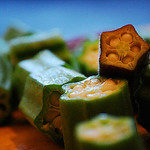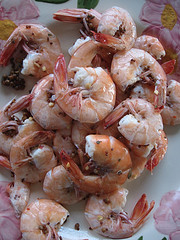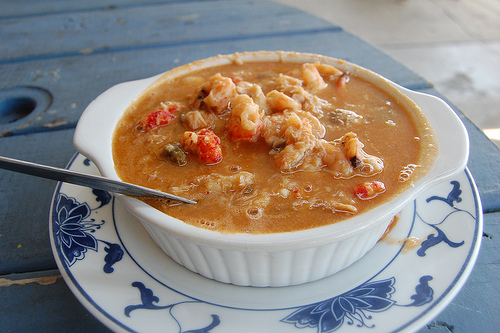TW Column by Emily Toth
Cooking Up a Spicy Stew of a Book
“Emily Toth’s new novel is a spicy gumbo of romance, sex, war, and unforgettable characters,” somebody once wrote about my 1983 novel, Daughters of New Orleans.
 I can’t find the review—it was before Google and the Net—but it’s good for reminiscing. Daughters of New Orleans, long out of print, was a great pleasure to write. It didn’t feed tenure committees. (“Trash,” said one colleague.) It was seasoned totally to my taste. It was my first literary gumbo.
I can’t find the review—it was before Google and the Net—but it’s good for reminiscing. Daughters of New Orleans, long out of print, was a great pleasure to write. It didn’t feed tenure committees. (“Trash,” said one colleague.) It was seasoned totally to my taste. It was my first literary gumbo.Daughters is about five young women who come of age in New Orleans during the 1860s, with the fire of war and the stirrings of forbidden feelings. One goes North, and one dies in childbirth, and one becomes a writer (the one who looks like me). There’s a comical riverboat interlude with a flame-haired adventuress and a roguish gambler. There’s a wrenching story of an octoroon who passes for white, leaving behind her entire past.
I thought of my novel as a jambalaya—a one-pot dish made with white rice, hot sausage, ham, green peppers, garlic, and onions. In jambalaya, the ingredients are cooked together in a stock flavored with thyme and cayenne and other spices, but the end result is served dry on a plate, not in a liquid. Each ingredient keeps its own identity, much as I aimed to create a distinct identity for each of my characters.
The truth is, I probably did write a gumbo. Jambalaya is mostly home cooked, but gumbo is mass produced and can be found everywhere. There’s even a mostly veggie version (gumbo z’herbes). I suppose one could make a tofu gumbo, but it wouldn’t have the same heart or heritage.
In a gumbo, everything’s a liquid stew in one pot, and the ingredients—meat or shellfish, vegetables, spices—all blend together with the roux, the thickening soup base made of flour and butter or oil. It takes skill and talent to make a roux just right without burning it. (Some cowards—I don’t name names—buy their roux in a jar.)
 The final gumbo broth is a mélange of all the ingredients, and each spoonful has a unique taste—the meat or seafood itself, but also an afterbite from the way the spices mix in that spoonful.
The final gumbo broth is a mélange of all the ingredients, and each spoonful has a unique taste—the meat or seafood itself, but also an afterbite from the way the spices mix in that spoonful.That’s what I hoped for my characters: that each would stand out, that they’d blend for awhile, that the reader would be left with an individual flavor or afterbite. And, of course, remember and savor them forever.
In case you’re wondering, I never did manage to sell another novel. My agent tried; no one bit. I never pulled off the right gumbo mix again—but it’s still a good metaphor for what grander folks call “the writing process.”
Writing does start with a roux: the basic subject matter. Often, especially with a novel, you don’t always know exactly what will be in the roux.
Edith Wharton sometimes began with a word (“Testvalley” for her last novel, The Buccaneers). Other writers start with a “What if?” (What if a cagey Southern belle got sidetracked by war-war-war?) For an action story, you could start with a primal fear (sharks!). If it’s a romance, you need an anti-spark (she’s an arsonist; he’s a firefighter—a classic example from bestselling author Sandra Brown). If it’s a mystery, you’ve got to have a dead body (whose?—there are soooo many possibilities).
If you’re a first-time novelist, the tendency is to throw all possible ingredients on top of your roux. There’s your hatred for your dad; your sympathy with your mom; your annoyance with that first love who dumped you. Eventually, though, you’ve got to leave out some of those pesky critters, or you’ll have an endless autobiographical screed.
(If you do and you’re male, some reviewers may consider you brilliant. If you’re female, words like “shrill” and “hysterical” will be tossed around. Someone will tell you to keep it in your blog, sugar.)
After the roux, you sauté your onions and vegetables, who are—unless you’re a vegetarian—decidedly supporting characters. They’re what E. M. Forster called the “flat characters,” the stereotypes who don’t change or grow (they’re still saying, “Bah humbug!” at the end).
By the way, I’m not the only one to equate supporting characters with vegetables. When Margaret Thatcher was British prime minister, the story goes that she was dining with her male underlings, and she ordered steak. “And the vegetables?” the server asked—whereupon Thatcher replied, “They’ll have steak, too.”
In gumbo, the meat—Forster’s “round character”—is a big decision: seafood (crab, shrimp) or turf (chicken, duck, sausage)? Usually they’re not mixed, though there are no rules you absolutely must follow. Anybody can be a main character in your gumbo, including squirrel or road kill. (A favorite assignment in business classes at my school is “Design a Road Kill Restaurant,” which involves ways to hype muskrat, nutria, and other rodents who throw themselves under your wheels, along with the usual suicidal armadillos.)
What the main characters do is up to the chef—and usually, as any novelist knows, they do take on a life of their own. Food is less likely to rebel. I’ve never heard of an alligator part rising out of the gumbo pot and hissing, “You stew me at your peril!” But who knows what happens when the electrical power goes out, as it did during Hurricane Isaac this summer, and all those once-living things in the freezer thaw?
Once Isaac left us, I thought I would wax literary about the food that sustained us—and gather a little data for this column. I trekked to a dozen Baton Rouge-area restaurants, seeking what each menu might say about its gumbo. I wanted “pungent!” and “zesty!” I wanted the kind of extravagant descriptions one finds in la-di-da establishments: “bathed in virgin olive oil, infused with the rhythms of bay leaf, swooning to the siren song of the swamp.” I wanted writerly words.
Instead, I was most likely to find (and I quote the entire listings from actual menus): “Seafood Gumbo” and “Duck Andouille Gumbo.” I found one “Fried Chicken Gumbo.” Yet, despite the boring uniformity of their descriptors, the gumbo tastes varied a lot—salty, pepperish, smoky. I think this will be a lifetime study.
Like all good things, gumbo is—of course—also a metaphor for life. Throw in the sheep with the goats. Take what you need and leave the rest. And watch out for The Man.
In preparation for the October 2012 World Championship Gumbo Cookoff in New Iberia, Louisiana, the local Chamber of Commerce warned that the "Gumbo Police" would inspect each team’s ingredients and cooking methods and make sure they followed the “Gumbo Code of Ethics.”
I have no idea what that means, but doesn’t it sound like a great idea for a novel?
Publishing Information
 Daughters of New Orleans, by Emily Toth (Bantam Books, 1983).
Daughters of New Orleans, by Emily Toth (Bantam Books, 1983).- Aspects of the Novel by E. M. Forster (Edward Arnold Publishers Ltd, 1927).
- The Buccaneers, by Edith Wharton (Appleton & Co., 1938).
- Thatcher quote: The Oxford Dictionary of Humorous Quotations, by Ned Sherrin (Oxford University Press, 1995).
- Rules for the 23rd World Championship Gumbo Cookoff: Greater Iberia Chamber of Commerce website.
Art Information
- "Okra" © Rebecca Wilson; Creative Commons license
- "Boiled Shrimp" © Jeremy Keith; Creative Commons license
- "Breaux Bridge: Frenchified Seafood Gumbo at Chez Jacqueline" © Southern Foodways Alliance; photo by Sara Roahen; Creative Commons license
 Emily Toth is a contributing writer at Talking Writing, where her column “Nothing but the Toth” appears regularly.
Emily Toth is a contributing writer at Talking Writing, where her column “Nothing but the Toth” appears regularly.
“Luckily for me, my mother came from an immigrant culture, only one generation removed from the shtetl. Eating was treasured. The anxious table talk was always ‘Did you get enough to eat?’ and never ‘Put that down. You’ll get fat.’” — Gluttony: The Good Eater

